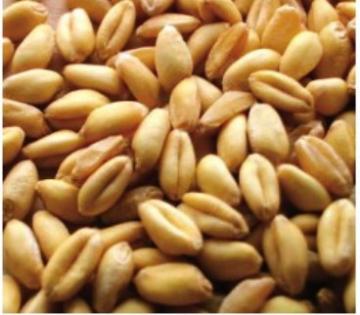
Wheat (Triticum aestivum)
Local names: Hindi: Gehun Kannada: Godhi Manipuri: Gehun Marathi: Gehun Sanskrit: Arupa, Bahudugdha, Godhuma Tamil: Godumai, Godumbaiyarisi Telugu: Godumalu Urdu: Gehun
Wheat is the world`s most important crop. It is grown primarily for human consumption. Wheat belongs to the genus Triticum.
Nutritive value
Though wheat is a good source of energy containing 75-80% TDN, it is rarely used for livestock feeding in India due its higher cost and higher demand for human consumption. Only damaged wheat is used for feeding animals. Grain of wheat is highly variable in composition. Depending upon the variety, crude protein content ranges from 8-14%. Wheat is superior to maize in protein content and quality. Lysine, threonine and methionine are the major limiting amino acids in wheat grain. Climate, soil fertility and variety influence the protein content. The most important protein present in the endosperm is a prolamin and a glutelin. The mixture of protein present in the endosperm is often referred as gluten. The amino acid composition of these two proteins differs, glutenin containing about three times as much lysine as that present in gliadin. All glutens possess the property of elasticity. Glutens form dough which traps the gases produced during fermentation. Finely ground wheat forms a pasty mass in the mouth and rumen and this may lead to digestive upsets. Newly harvested wheat is apparently more harmful in this respect than wheat which has been stored for some time. When wheat grain is fed in large amounts, because of the rapid fermentation of the grain in rumen, animal is more prone to lactic acidosis.
Deleterious factor
There are no significant toxins in wheat. It is not normally infected with mycotoxin producing fungi, so mycotoxins are not of concern unless the grain is improperly stored. Occasionally it may be infected with ergot.
